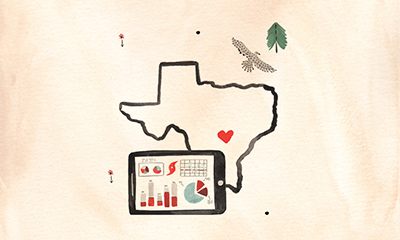
A blank line on a job application reads: phone number.
For a certain population of job seekers, the empty space inspires dread. An applicant may pause, pen poised over the form, and think, Even if this manager wants to follow up, how will she reach me?
The importance of those seven digits to a person who is homeless was a wake-up call for John Yazwinski '96.
As a Bentley student, the former Marketing major worked with faculty and a phone company to implement a voice mailbox system for people living at a homeless shelter.
"It was just one simple thing … that could help someone move out of a shelter," Yazwinski recalls, his joy and wonder at the discovery still apparent.
It was just one simple thing … that could help someone move out of a shelter.
John Yazwinski '96
Fast forward to the early 2000s. The alumnus is executive director at Father Bill's Place, a shelter based in Quincy, Mass. It's filled to capacity just about every night and Yazwinski is in search of a way to meet demand. Technology developed for business — by a friend and Bentley classmate — would point the way.
Matthew Simmonds '96 is CEO of Simtech Solutions, a software firm he established to serve the leasing industry. He and Yazwinski used data collection and analysis to uncover a narrative behind the numbers: a few people were using the largest amount of resources.
"The conversation changed. We went from managing homelessness to potentially ending it,"Yazwinski says, referring to a then-new ambitious and innovative "housing-first" model. Father Bill's was a pioneer of the approach, which is gaining ground in cities of all sizes.

The solution was to develop multifamily housing units. Their first project was Claremont House, located in a shipyard and already set up to house multiple people.
About a dozen women — some of the highest utilizers of Father Bill's services — moved in. And costs went down, internally and externally.
What other cues can nonprofits take from the corporate world? What can business learn from charitable organizations? Yazwinski, Simmonds and other Bentley alumni and faculty members are part of a growing movement to build bridges between the sectors.
THE RIGHT MINDSET: AN ETHICAL APPROACH
According to the Edelman 2017 Trust Barometer, public confidence in both companies and nonprofits — and their leaders — is slipping. The report shows that, worldwide, trust in CEOs is at an all-time low of 37 percent. Nationally, the United States has experienced a five-point loss in the category between 2016 and 2017. On a more positive note, 75 percent of respondents agree that businesses can take action to increase profits while improving social and economic conditions in their communities.
Transparency, accountability and ethical leadership are at the heart of corporate social responsibility (CSR). The principles must be part of educating future business leaders, says Cynthia Clark, associate professor of management and director of Bentley's Harold S. Geneen Institute for Corporate Governance.
It’s important to teach our students about the responsibility firms have to society.
Professor Cynthia Clark
"Reflecting the results of the Edelman survey, businesses perform many functions in society and are embedded in sociopolitical systems globally. So it's important to teach our students about the responsibility firms have to society," she explains. "This responsibility is expressed most often in terms of CSR, which itself can take many forms. Students also need to understand how to balance this responsibility with the role that firms play in the economy."
THE RIGHT DATA: LOOKING BEHIND THE NUMBERS
Storytelling has long been a practice in nonprofit fundraising. Businesses also benefit from the power of a personal story in ad campaigns. Data too can tell a story — and that’s exactly how Yazwinski and his colleagues transformed Father Bill’s mission and contributed to a national shift in addressing homelessness.
Still, he and Simmonds note the challenge of getting other agencies on board with the housing-first model. This is why data analysis and solid business presentation skills matter. Comparing the pre- and post-housing numbers revealed significant decreases in medical, social service and law enforcement costs.
"We're excited about using that data to educate, to prove outcomes,"Yazwinski says, adding that the model not only saves money, but also improves well-being. "It’s healthier and more efficient than ricocheting in and out of emergency rooms, treatment facilities and jail."
For Simmonds, the collaboration revealed an untapped market. The Counting Us product that his company developed is in use by cities for the annual homeless count; this federally mandated exercise helps determine government funding and resource allocation.
No matter what the charitable organization, approaching problems with an analytical mindset — digging a little deeper — could reveal a revolutionary idea.
THE RIGHT TOOLS AND TECHNOLOGY
Collaboration around technology and development is a primary focus for NetHope, a consortium of more than 50 global nonprofits. Its survey of members in 2017 found that 70 percent do not have a digital strategy.
This is where professionals like Stamatina (Tina) Papadopoulos '88 come in. She's a consultant to small and startup nonprofits, assisting clients with everything from fundraising to finance to marketing to event planning. 
Papadopoulos aims to bring a fresh perspective to groups that are often set in their ways. She sees passion, but says growth is often stymied by fear of change or lack of time.
"It's detrimental and a time suck for nonprofits to not be organized and use the latest tools," she says, adding that much of her work is dedicated to getting clients organized and more business-like.
For example, she encourages groups to move away from paper. Staying current with finance and accounting trends, such as using QuickBooks or automating payments, not only saves time, but also maintains consistency through board transition and turnover. She's a big believer in standardizing processes and business procedures, something that’s usually second nature in a corporate environment. The time saved from streamlining these tasks could be spent on fundraising and marketing.
Papadopoulos considers data analytics a compelling reason to embrace technology. Digitizing records could uncover missed opportunities or inspire new metrics, such as how much an event costs per square foot or how looking at the big picture could reveal that an annual event perceived as successful has actually become stagnant.
"You could create graphs to show stakeholders and be more confident in your presentations," she says, noting that such illustrations are far more effective than passing around a spreadsheet. "You can see what’s happening, see where your strengths and weaknesses are."
THE RIGHT PEOPLE IN THE RIGHT PLACES
Just as a hiring manager pores over résumés to find the best job candidate, nonprofit leaders should look closely at the skills, educational background and work experience of potential board members and volunteers.
Gerald R. Ferrera, MST '84, the Gregory H. Adamian Professor of Law, Emeritus, has a long association with nonprofit organizations. He has done pro bono work in his own profession, offered service-learning components in his courses, and volunteered for upward of 27 years at Boston-based day shelter St. Francis House.
"Some nonprofits have developed into highly sophisticated business entities, with board members who include partners from accounting and law firms, and other high-ranking executives," he says. "Their experience is useful, as they insist on managers applying the latest business strategies and technologies in implementing their policies."
Choosing the right people to move organizations forward is a particular challenge for the small nonprofits that Papadopoulos works with. She routinely advises them to seek out business leaders whenever opportunities arise.
"Let’s face it: Passion is good," she says. "But when you bring expertise to the board, everyone's job becomes easier."
THE RIGHT MESSAGE
Nonprofits can learn a lot about operations, marketing and finances from business. But what can businesses learn from community-minded organizations?
Corporations are discovering the business value of a well-developed social conscience. A survey conducted in 2017 by FleishmanHilliard Research and Lightspeed GMI showed that 83 percent of professional investors are more inclined to buy shares of a company well-known for social responsibility, because it’s "an indicator of greater transparency and honesty in operations and financial reporting, resulting in lower risk."
In the business environment, Ferrera sees "an emerging synergy between for-profit corporations and nonprofits to address social issues on a level that is increasingly attractive to consumers and donors alike."
Corporate foundations allow companies to do good — and look good. These usually independently operated philanthropic arms donate time and money to causes in their local communities and beyond through grants, service, matching gifts, sponsorships and more.
Impact investing — financially supporting efforts that drive social change and also see a return — is on the rise as well. Giving USA Foundation reports that corporate giving was up 3.5 percent in 2016, for a total of $18.55 billion. Fortune 500 companies are in fact making a powerful statement that giving back matters.
Gary Morton '97, MBA '12 directs Liberty Mutual’s Give with Liberty initiative, the employee giving division of the company’s foundation.
 "I can’t think of a better reason to go to work every day," says the alumnus, whose strategy background and financial acumen — the idea of driving engagement and reducing expenses — have taken the program to new levels. Now, more than 70 percent of Liberty employees participate, raising more than $18 million to be distributed to 8,317 charities across the country.
"I can’t think of a better reason to go to work every day," says the alumnus, whose strategy background and financial acumen — the idea of driving engagement and reducing expenses — have taken the program to new levels. Now, more than 70 percent of Liberty employees participate, raising more than $18 million to be distributed to 8,317 charities across the country.
Social problems are significant, Morton says. And it takes a lot of resources to address, prevent and eradicate issues. He says corporate philanthropy helps mitigate the gap between individual donations, grants and other support. This goes beyond payroll deduction programs. Morton and Ferrera are advocates of "service days," through which employees volunteer during paid business hours.
Ferrera sometimes crosses paths with corporate volunteers at St. Francis House. "I see how much they enjoy helping out using their exceptional business skills. And they’re so proud to wear their matching T-shirts."
The boost in morale and engagement is sure to carry over to their own workplace.
Your reputation — for better or for worse — is something you carry with you throughout your career.
Professor Clark
While Liberty Mutual and similarly large corporations house foundations, others choose to partner with a social mission they care about. Management professor Clark sees mutual benefits.
"Businesses are focused on surviving as a business, while the stereotype is that nonprofits are super-energized and focused on their mission. These collaborations create a natural union — each can do what is perhaps their core competency."
THE RIGHT OUTCOMES
"We all want a vibrant community," says Yazwinski. "We’ll always have people who struggle with housing, education, substance abuse. It's going to take not just the public sector, but also the business community and the faith community."
Morton sees firsthand how employees are motivated by working for a company that collectively cares. His own motivation: "save lives, change lives, give people an opportunity. We should be doing that as corporate citizens."
As the voicemail project that initially inspired Yazwinski shows, even the simplest gestures can make a big difference. A business can start its community efforts on a small scale, such as initiating a day of service. A nonprofit can ease into implementing technology for its day-to-day operations. And, the collaboration between Simmonds and Yazwinski is a shining example of how a civic-minded business and a business-savvy community organization can do good when they join forces.
Finally, Clark reminds us that everything may start with personal integrity, as these alumni demonstrate. Staying true to yourself is something she stresses in her work with students. As she tells them: "Your reputation — for better or for worse — is something you carry with you throughout your career."
ACTING FAST IN TEXAS AND BEYOND
 Simtech’s Counting Us app was developed to help the homeless community, but it recently found a surprising and welcome use: disaster recovery.
Simtech’s Counting Us app was developed to help the homeless community, but it recently found a surprising and welcome use: disaster recovery.
Mother Nature does not discriminate, and people not typically thought to be "at risk" for homelessness can suddenly find themselves and their pets living in churches, stadiums and warehouses.
In August, two of the largest shelters in Houston used Counting Us to help kickstart the process of moving people impacted by Hurricane Harvey back into stable housing. Matt Simmonds '96 reports that within the first few days, staff and volunteers had completed more than 3,800 interviews.
"Once the data is collected, they will have a better sense of what kinds of help are needed," he says."They can also use this information to help guide people to the services and resources that are the best fit for their needs."
Puerto Rico has since voted to use Counting Us to aid in the recovery from Hurricane Maria; regions in Northern California are also considering the app to help after the wildfires in early October. Simmonds, of Canton, Mass., remembers feeling helpless at first as he watched the news reports from Texas. Years ago, he might have put together a service trip with fellow Bentley students to help with recovery efforts.
"That's a lot harder to do now that I have a family and a career," he says. "But at least we can use technology to do what we can from up here."

